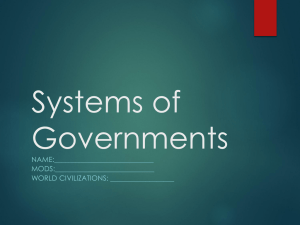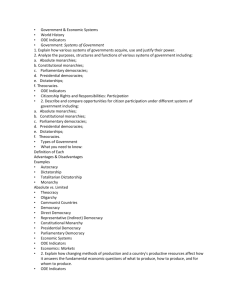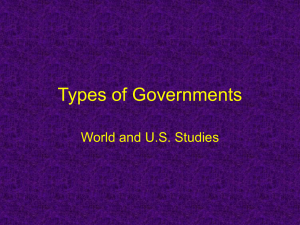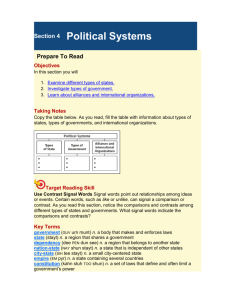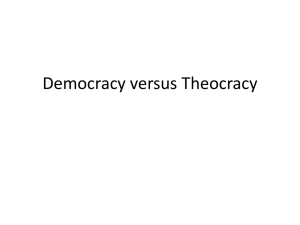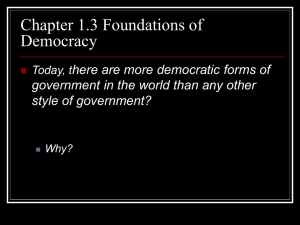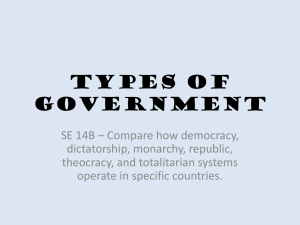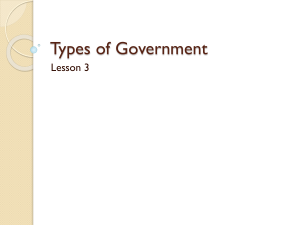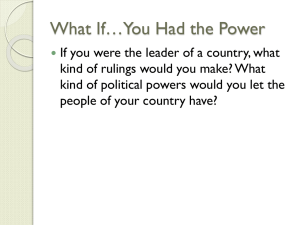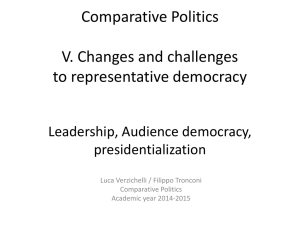Forms of Governments PPT
advertisement
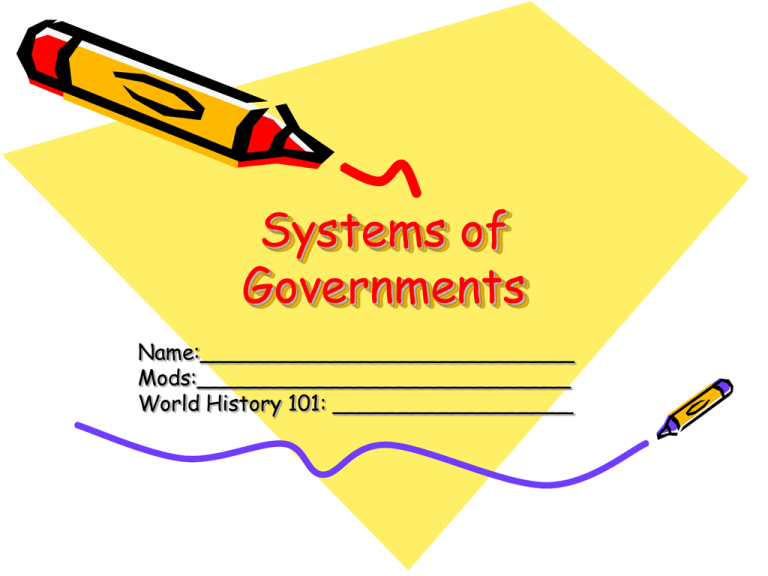
Systems of Governments Name:____________________________ Mods:____________________________ World History 101: __________________ Ohio Content Standards Government Systems of Government 1. Explain how various systems of governments acquire, use and justify their power. 2. Analyze the purposes, structures and functions of various systems of government including: a. Absolute monarchies; b. Constitutional monarchies; c. Parliamentary democracies; d. Presidential democracies; e. Dictatorships; f. Theocracies. I. Absolute Monarchies • A. Absolute Monarch: A king or queen who has unlimited power and seeks to control all aspects of society. • B. Absolute Monarchs acquire power through birth. • C. Disadvantages of Absolute Monarchies: 1. an absolute monarch cannot be questioned. 2. The freedoms of individual citizens are often limited. 3. Freedom of speech and press are not guaranteed. 4. There are few checks on authority therefore, a king or queen does not have to respect the rights of the people. II. Examples of Absolute Monarchies • A. Then – 1. The Reign of King Louis XIV of France 1643-1715 – 2. King George III of England B. Now • 1. Saudi Arabia a. The world’s leading producer of crude oil. b. Present ruler is King Abdullah. c. Opposition to the king is not tolerated. d. Citizens are not free to speak out against the government. e. Citizens cannot take part in elections to choose public officials. f. All Saudi officials are appointed by the king, not elected by the people. II. Constitutional Monarchies • A. Constitutional Monarch: A system of governing in which the ruler’s power is limited by law. • B. The country’s laws are determined by a Constitution or Bill of Rights. • C. A constitution is a document that lists many things that a ruler cannot do. • D. For example, No interfering with freedom of speech or religion. • E. Constituitions limit a monarch’s power; therefore real power belongs to elected officials, not the king or queen. • F. Usually constitutional monarchies have a legislative branch. • G. In England, the legislative branch is called Parliament. III. Example of a Constitutional Monarchy 1. A. Great Britain: Queen Elizabeth II • B. Although Great Britain has a royal family, it also has a Constitution, Parliament, and a Prime Minister. IV. Dictatorships • A. Dictatorship: A system ruled by a dictator possessing absolute power and absolute authority. • B. A dictator usually takes power of a preexisting government by military force. • C. This take-over is called a coup d’etat. • D. Dictators usually appoint a police force that uses threats and actual force to stop anyone from saying anything against the dictatorship. V. Examples of Dictators of the Past and Present • A. Adolf Hitler Nazi Germany B. Saddam Hussein Iraq V. Cont. • A. Dictatorships are dangerous. A dictator rules with unlimited power and therefore can get away with inhumane treatment of their citizens. • B. Adolf Hitler was responsible for the mass slaughter (genocide) of 6 million Jewish people during WWII. • C. Human Rights Watch estimates that Saddam's 1987-1988 campaign of terror against the Kurds killed at least 50,000 and possibly as many as 100,000 Kurds. The Iraqi regime used chemical agents to include mustard gas and nerve agents in attacks against at least 40 Kurdish villages between 1987-1988. The largest was the attack on Halabja which resulted in approximately 5,000 deaths • D. North Korea Kim Jong Il of North Korea. • E. Kim Jong Il’s regime is very secretive and completely isolated from the rest of the world. • F. He has been accused of supporting terrorism and in 2005 announced that North Korea had developed nuclear weapons. VI. Theocracy • A. Theocracy: A government controlled by religious leaders. • B. A present day example of a theocracy is Iran. • C. Iran is officially titled, The Islamic Republic of Iran VI. Theocracy Cont. • D. All secular (nonreligious) laws passed in Iran are reviewed by a 12 member Council of Guardians. • E. The Council is made up of six Muslim religious experts and six Muslim attorneys. • F. All laws must be consistent with Islamic religious laws. VII. Parliamentary Democracies A. Democracy: a government where the power is vested in the citizens to make laws for their own society usually involving periodically held free elections. B. Power for a democracy is acquired through elections. C. Parliamentary Democracies: A body of representatives elected by the people of a nation to make laws. D. Once elected, the members of parliament elect a chief executive and cabinet to run the government. • E. France, India, Israel and Canada are examples of a Parliamentary Democracies. F. Remember that Democracy means Freedom for its citizens. VIII. Presidential Democracy • A. Presidential democracy: All citizens can vote to decide who becomes the chief executive (president) of a nation. • B. This means that a president must answer directly to the people. • C. The United States is an example of a presidential democracy. • D. The President serves as the Executive Branch of the country’s government. Types of Government Absolute Constitutional DictatorMonarchyMonarchy ship Theocracy ParliamentaryPresidential Democracy Democracy Quiz Study Questions You need to know…. 1. Definitions of the six types of governments. 2. How leaders acquire power in the six government system ex.)Absolute Monarchy: Power passed down from a parent to a child Dictatorship: Power taken by force Representative Democracy: leaders are elected by the people of the nation 3. Countries’ government systems ex.) Presidential Democracy: U.S.A. Theocracy: Iran Dictatorship: Saddam Hussein/Iraq, Hitler/Nazi Germany
